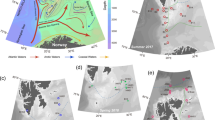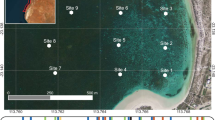Abstract
Severe red tides due toChattonella antiqua occur sporadically during summer in the Seto Inland Sea, Japan, and cause significant damage to the fishing industry. In order to assess the chemical environment with respect to the outbreak ofC. antiqua, environmental factors that affect the growth ofC. antiqua were monitored around the Ie-shima Islands, the Seto Inland Sea, in the summer of 1986. In addition, a growth bioassay of the seawater usingC. antiqua was conducted under a semicontinuous culture system. Although temperature, salinity and light intensity were optimum for the growth ofC. antiqua, red tides by this species did not occur. Concentrations of NH +4 , NO −3 and PO 3−4 were low (<0.4, <0.2, <0.06 µM, respectively) above the thermocline (8–12 m) and high below it (0.6–2, 4–8, 0.4–0.8 µM, respectively). Vitamin B12 concentrations did not change significantly between the surface (0 m) and below the thermocline (25 m) in the level of 2–4 ng·l−1. The growth bioassay revealed that in the surface waters, concentrations of N- as well as P- nutrients were too low to support a rapid growth ofC. antiqua. At the depth of 25 m, neither N, P nor B12 limited the growth rate.
In order to obtain more quantitative information on the growth rate as a function of the concentrations of N- and P- nutrients,C. antiqua was grown in a semicontinuous culture system by changing nutrient concentrations systematically. The observed growth rate (μ) can be approximated as follows:
whereS N is the concentration of NO −3 plus NH +4 (0–6 µM),S PO, the concentration of PO 3−4 (0–0.6 µM), μmax (0.97 d−1) the maximal growth rate,K N0 (1.0 µM) andK P0 (0.11 µM) the half saturation constants for NO −3 and PO 3−4 , respectively. Using the above equation with nutrient concentrations measured, the rate at which seawater supports the growth ofC. antiqua can be estimated and this can be used for the assessment of chemical environments with respect to the outbreak ofC. antiqua.
Similar content being viewed by others
References
Bandschneider, K. and R.J. Robinson (1952): A new spectrophotometric determination of nitrite in seawater. J. Mar. Res.,11, 87–96.
Dortch, Q., J.R. Clayton, Jr., S.S. Thoresen, J.S. Cleveland, S.L. Bressler and S.I. Ahmed (1986): Nitrogen storage and use of biochemical indices to assess nitrogen deficiency and growth rate in natural phytoplankton populations. J. Mar. Res.,43, 437–464.
Droop, M.R. (1974): The nutrient status of algal cells in continuous culture. J. Mar. Biol. Assoc. U.K.,54, 825–855.
Endo, T., H. Koyama and H. Imabayashi (1982): Phytoplankton in Harima-Nada in relation to oceanographic conditions, particularly nutrient and physiological properties of seawater, p. 81–92.In: Fundamental studies on the effects of marine environment on the outbreaks of red tides. The Ministry of Education, Science and Culture, Japan. B148-R14-8.
Fishery Agency, Japan (1982): Data sheets on the red tides which occurred in 1977 (Showa 52-nendo akashiwo yosatsu jigyo chosa shiryo; in Japanese).
Fishery Agency, Japan (1983): Data sheets on the red tides which occurred in 1978 (Showa 53-nendo akashiwo yosatsu jigyo chosa shiryo; in Japanese).
Fishery Agency, Japan (1984): Data sheets on the red tides which occurred in 1979 (Showa 54-nendo akashiwo yosatsu jigyo chosa shiryo; in Japanese).
Guillard, R.R.L. and J.H. Ryther (1962): Studies of marine planktonic diatoms. I.Cyclotella nana Hustedt andDetonula confervacea (Cleve) Gram. Can. J. Microbiol.,8, 229–239.
Hamamoto, S., S. Yoshimatsu and T. Yamada (1979): Vertical migration ofHornellia (Chattonella antiqua) in the field, p. 42–44.In: Reports on red tides byHornellia occurred in Jun., 1978. Kagawa Prefecture, Japan (in Japanese).
Hata, Y. and T. Nishijima (1982): Distribution of aerobic heterotrophic bacteria and B group vitamins in Harima Nada. p. 109–119.In: Fundamental studies on the effects of marine environment on the outbreaks of red tides. The Ministry of Education, Science and Culture, Japan. B148-R14-8.
Imai, I. and K. Itoh (1987): Annual life cycle ofChattonella spp., causative flagellates of noxious red tides in the Inland Sea of Japan. Mar. Biol.,94, 287–292.
Iwasaki, H. (1971): Studies on the red tide flagellates-VI.Eutreptiella sp. andExuviaella sp. appeared in Bingo-Nada, the Seto Inland Sea, in 1970. J. Oceanogr. Soc. Japan,27: 152–157.
Iwasaki, H. (1979): Physiological ecology of red tides, p. 357–393.In: Biochemistry and physiology of protozoa, ed. by M. Levandowsky and S.H. Hutner, Vol. 1, Academic Press.
Kilham, S.S. (1986): Dynamics of Lake Michigan natural phytoplankton communities in continuous cultures along with a Si: P loading gradient. Can. J. Fish. Aquat. Sci.,43, 351–360.
Kishi, M. and S. Ikeda (1986): Population dynamics of ‘red tide’ organisms in eutrophicated coastal waters—numerical experiment of phytoplankton bloom in the east Seto Inland Sea, Japan. Ecol. Modelling,31, 145–174.
Maestrini, S.Y., D.J. Bonin and M.R. Droop (1984): Phytoplankton as indicators of seawater quality: Bioassay approaches and protocols, p. 71–132.In: Algae as ecological indicators, ed. by L.E. Shubert, Academic Press.
Menzel, D.W. and N. Cowin (1965): The measurement of total phosphorus in seawater based on the liberation of organically bound fraction by persulfate digestion. Limnol. Oceanogr.,10, 280–282.
Murphy, J. and J.P. Riley (1962): A modified single-solution method for the determination of phosphate in natural waters. Anal. Chim. Acta.,27, 31–36.
Nakamura, Y. (1985a): Ammonium uptake kinetics and interactions between nitrate and ammonium uptake inChattonella antiqua. J. Oceanogr. Soc. Japan,41, 33–38.
Nakamura, Y. (1985b): Kinetics of nitrogen- or phosphorus-limited growth and effects of growth conditions on nutrient uptake inChattonella antiqua. J. Oceanogr. Soc. Japan,41, 381–387.
Nakamura, Y. (1985c): Alkaline phosphatase activity ofChattonella antiqua andHeterosigma akashiwo. Res. Rep. Natl. Inst. Environ. Stud., Jpn.,80, 67–72.
Nakamura, Y. and M.M. Watanabe (1983a): Growth characteristics ofChattonella antiqua (Raphidophyceae) Part 1. Effects of temperature, salinity, light intensity and pH on growth. J. Oceanogr. Soc. Japan,39, 110–114.
Nakamura, Y. and M.M. Watanabe (1983b): Growth characteristics ofChattonella antiqua Part 2. Effects of nutrients on growth. J. Oceanogr. Soc. Japan,39, 151–155.
Nakamura, Y. and M.M. Watanabe (1983c): Nitrate and phosphate uptake kinetics ofChattonella antiqua grown in light/dark cycles. J. Oceanogr. Soc. Japan,39, 167–170.
Nakamura, Y., K. Sawai and M. Watanabe (1987): Growth inhibition of a red tide flagellateChattonella antiqua by copper. J. Oceanogr. Soc. Japan,42, 481–486.
Ono, C. and T. Takano (1980):Chattonella antiqua (Hada) comb. nov., and its occurrence on the Japanese coast. Bull. Tokai Reg. Fish. Res. Lab.,102, 93–100.
Rhee, G-Y. (1978): Effects of N: P atomic ratios and nitrate limitation on algal growth, cell composition, and nitrate uptake. Limnol. Oceanogr.,23, 10–25.
Smith, S.V., W.J. Kimmerer and T.W. Walsh (1986): Vertical flux and biogeochemical turnover regulate nutrient limitation of net organic production in the North Pacific Gyre. Limnol. Oceanogr.,31, 161–167.
Solórzano, L. (1969): Determination of ammonia in natural waters by the phenolhypochlorite method. Limnol. Oceanogr.,14, 799–801.
Uye, S. (1986): Impact of copepod grazing on the red-tide flagellate,Chattonella antiqua. Mar. Biol.,92, 35–43.
Wood, E.P., F.A. Armstrong and F.A. Richards (1967): Determination of nitrate in seawater by cadmium-copper reduction to nitrite. J. Mar. Biol. Assoc. U.K.,47, 23–31.
Yentsch, C.S. and D. Menzel (1963): A method for the determination of plankton chlorophyll and phaeophytin by fluorescence. Deep-sea Res.,10, 221–231.
Author information
Authors and Affiliations
Rights and permissions
About this article
Cite this article
Nakamura, Y., Takashima, J. & Watanabe, M. Chemical environment for red tides due toChattonella antiqua in the seto inland sea, Japan. Journal of the Oceanographical Society of Japan 44, 113–124 (1988). https://doi.org/10.1007/BF02302618
Received:
Revised:
Accepted:
Issue Date:
DOI: https://doi.org/10.1007/BF02302618




